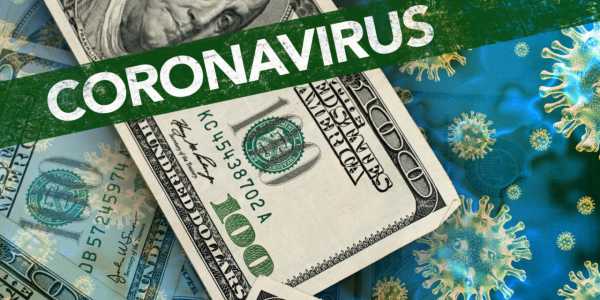To fight COVID-19 and the coronavirus pandemic, Congress in March 2020 passed three separate economic relief bills to help struggling individuals and businesses.
The first was the $8.3 billion Coronavirus Preparedness and Response Supplemental Appropriations Act of 2020.
The second initiative was the $3.5 billion Families First Coronavirus Response Act.
And the largest of the three measures was the $2.2 trillion Coronavirus Aid, Relief and Economic Security Act, or the CARES Act.
As of this writing, President Donald Trump, House Speaker Nancy Pelosi and others in Washington, D.C. are already talking about a future “Phase 4” initiative to further expand financial support to Americans amid the COVID-19 emergency.
But you don’t have to wait, because you undoubtedly still have bills to pay now.
So if you’re in need of some fast money right away – and who isn’t, given the economic fallout from the coronavirus crisis? – below are seven cash benefits packed into the existing federal stimulus packages.
Tap into all seven perks below and you could put $10,000 to $20,000 into your bank account in just one month.
Even if you’re not eligible for every single program described below, take advantage of as many of these benefits as possible, to get some coronavirus cash of your own.
Be sure to also bookmark this content, and return here for ongoing coronavirus money tips and additional COVID-19 financial updates as they become available.
Individuals and members of the media may also share this information, with proper attribution to AskTheMoneyCoach.com and a link to this Coronavirus Cash resource.
- Direct Cash Payments
Amounts: $1,200 per adult and $500 per child age 16 and under
Eligibility: Individuals earning up to $75,000 and couples making up to $150,000.
Details: There are income phase-outs, so individuals earning above $99,000 and couples with combined incomes above $198,000 won’t get anything from these payments.
Explanation: The IRS calls these funds Economic Impact Payments. They’re one-time payments designed to help struggling Americans make it through the coronavirus crisis. Most taxpayers will automatically get these payments deposited into their bank account if you’ve filed a 2019 or 2018 tax return and the IRS has your banking data on hand. Otherwise, you’ll get a check in the mail.
- Unemployment Benefits
Amounts: Average benefit: $972 a week or $3,888/month
Eligibility: People who have been laid off, furloughed or had their job hours reduced.
Details: The average unemployment benefit in the United States is $372 per week, but benefits currently range from a low of $235 a week in Mississippi to a high of $795 per week in Massachusetts.
Regardless of where you live, the CARES Act gives everyone on unemployment a special $600 per week additional payment, through July 31, 2020. The Act also makes millions more Americans eligible for unemployment – including part-time workers, self-employed people, independent contractors and freelancers. Previously, these individuals did not qualify for unemployment benefits.
Explanation: The length of unemployment insurance also varies from state to state. But most states provide unemployment benefits that last for 26 weeks. With the new $2 trillion coronavirus legislation, unemployment benefits are temporarily extended by 13 weeks in every state, and can last a maximum of 39 weeks.
- Emergency Paid Sick Leave
Amounts: Average benefit: $936 a week or $1,872 for 10 days
Eligibility: Government employees; people who work for private employers that have fewer than 500 employees; and those working for any other non-private entity that has more than one employee. Self-employed individuals and gig economy workers are also eligible for sick leave benefits, via a tax credit from Uncle Sam.
Details: If you work for one of the organizations described above, federal law requires your employer to give you two weeks of paid sick leave if you’re unable to work (or telework) due to these coronavirus-related reasons:
- You are subject to a Federal, State, or local quarantine or isolation order related to the coronavirus;
- You have been advised by a health care provider to self-quarantine due to concerns related to the coronavirus;
- You are experiencing symptoms of coronavirus and are seeking a medical diagnosis;
- You are caring for an individual who is subject to a quarantine or isolation order or advised to self-quarantine by a health care provider;
- You are caring for a child whose school or care provider is closed or unavailable due to coronavirus precautions;
- You are experiencing any other condition substantially similar to the coronavirus, as specified by the U.S. Department of Health and Human Services.
Explanation: Because of COVID-19, federally-mandated sick pay covers 100% of your salary up to $511 per day, or a maximum total of $5,110 over a two-week timeframe during the period beginning April 1, 2020 through December 31, 2020.
But realistically, most people won’t get $511 a day because sick pay is based on your earnings, and the average American earns $48,672 per year, according to Labor Department figures.
Using the $48,672 annual earnings statistic, that works out to $936 a week, or $187.20 per day. So over the course of two weeks, or 10 workdays, the average American earning $187.20 a day will get $1,872 in sick pay.
- Paid Family Leave
Amounts: About $625 a week or $2,500 a month
Eligibility: Those unable to work (or telework) because they must care for a child under 18 whose school or care provider is closed or unavailable due to a coronavirus emergency as declared by a Federal, State, or local authority.
Details: Under the law, the first 10 days of your emergency leave may be unpaid. You can also choose, or your employer may legally require you, to substitute any of your accrued paid vacation leave, personal leave, or medical/sick leave for unpaid leave.
After 10 days of unpaid leave, your employer is required to provide paid leave worth 2/3rds of your regular pay, up to $200 a day and a maximum total of $10,000. Self-employed individuals and freelancers are also eligible for $10,000 worth of medical leave benefits, by seeking a tax credit or refund from the IRS.
But even though federal leave benefits can be as high as $10,000, the average American worker who takes full advantage of this compensation over the full 10 weeks will get $6,250.
Reminder: The typical U.S. employee earns $936 a week, or $187.20 per day. So 2/3rds of $187 is $125 a day in medical leave pay.
In a five-day workweek, average family leave benefits would amount to $625. In one month, they would add up to $2,500. And in 10 weeks, typical leave pay becomes $6,250.
Explanation: The Families First Coronavirus Act basically expands upon the Family and Medical Leave Act (FMLA) in order to give employees the right to take up to 12 weeks of leave, without worrying about losing their job.
- Free Food
Amounts: About $250 to $500 a month saved
Eligibility: Low-income individuals, kids and families; plus the elderly, the disabled, and Native Americans
Details: The Families First Coronavirus Act allocated more than $1 billion to go toward food and nutrition support for certain vulnerable populations. Expanded SNAP benefits are now provided for families with students who are on free and reduced lunch programs at their schools. Free food is available if a family has a student whose school is closed for 5 days or more due to coronavirus. The Department of Health and Human Services has also earmarked $250 million for “Aging and Disability Services Programs” for nutrition.
Of that $250 million total, $160 million goes toward home-delivered nutrition services, commonly known as Meals on Wheels; $80 million goes toward providing free food at places like senior citizens centers and adult daycare facilities; and $10 million is for nutrition services for Native Americans/Indians.
Explanation: The average family of four spends about $1,000 a month on food. So even if free food is provided to one or two members of a low-income household, that’s a savings of $250 to $500 per month.
- Student Loan Relief and Refunds
Amounts: $383 a month saved or a $2,169 one-time refund to some
Eligibility: All individuals who owe federal student loans.
Details: The CARES Act didn’t cancel student loan debt, but it did provide a 6-month hiatus from making all federal student loan payments, including principal, interest and fees, through Sept. 30, 2020.
There are currently 44 million Americans who owe a total of $1.5 trillion in college loans, and most student loan debt is in the form of federal loans ($1.3 trillion). Since the average student loan payment is $383 a month, that’s a temporary boost in cash flow/savings to the typical borrower who won’t have to pay student loan obligations from April 2020 through September 2020.
Explanation: The CARES Act also gives major relief to those with delinquent and defaulted federal student loans. All federal student loan payment requirements have been halted, meaning no additional fees, interest or payments will accrue during the COVID-19 emergency. No collections or negative credit reporting will occur either.
The government is even refunding $1.8 billion to about 830,000 people with federal student loans who had defaulted on their loans and went through debt collection since Trump declared coronavirus a national emergency on March 13, 2020.
If the $1.8 billion is split among those 830,000 student loan debtors, that will result in an average refund, or one-time payment, of $2,169 per person.
- Small Business Loans and Grants
Amounts: $10,000 grants and up to $10 million in forgivable loans
Eligibility: Anyone who has been in business prior to Feb. 15, 2020, including small business owners with less than 500 employees; self-employed people; freelancers; part-time contractors; and anyone who receives a 1099
Details: In the $2 trillion CARES Act, one of the biggest financial bonanzas is $349 billion in SBA loans and grants being made available to entrepreneurs, sole proprietors, independent contractors and people with a side hustle.
Here’s a quick summary of 3 coronavirus-related loan programs from the SBA:
- Paycheck Protection Program Loans (PPP) – these are loans up to $10 million at an interest rate capped at 4%; All or part of the loans are forgivable under certain criteria
- Economic Injury Disaster Loans (EIDL) – these loans go as high as $2 million at 3.75%; Applicants can request up to $10,000 in free grants, which are supposed to be provided in 3 days of your application
- SBA Express Loans – these loans now have higher limits, up to $1 million from a previous cap of $350,000
- For PPP and EIDL loans, there are no personal guarantees; no SBA fees; no collateral; and no payments required for 6 months to 1 year
Explanation: The icing on the cake is the $10,000 free grant available to those who apply for an emergency coronavirus loan via the SBA’s EIDL program. Even if you are denied an actual loan, you get to KEEP the $10,000 grant — no strings attached.
Total Coronavirus Cash and Savings to You for Just one Month:
- Direct Cash Payment $1,200 or more
- Unemployment Compensation $3,888 on average
- Paid Sick Leave $1,872 on average
- Family Leave Benefits $2,500 on average
- Free Food $250 or more
- Student Loan Relief $383 or more
- SBA Grant $10,000
TOTAL Cash and Savings $20,093
As you can see, you can reap enormous financial COVID-19 benefits of $10,000 to $20,000 in a single month, just by knowing what coronavirus cash options and economic resources exist.
Feel free to share this information with others who may be cash-strapped and in need of financial guidance during these challenging times.
Above all: stay healthy and safe during the coronavirus pandemic!










